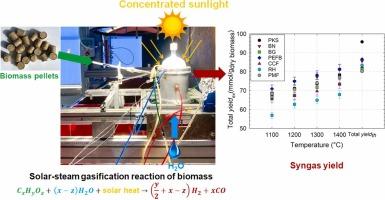Impact of different agricultural biomass residues on the performance of continuous solar-steam gasification
IF 6.2
1区 农林科学
Q1 AGRICULTURAL ENGINEERING
引用次数: 0
Abstract
Solar-driven biomass gasification represents a promising avenue for sustainable carbon-neutral fuel production. Nevertheless, the types of raw biomass materials play a vital role in continuous solar gasification performance. In this study, continuous solar-steam gasification with various agricultural crop residues was experimentally carried out in a 1.5 kWth solar gasifier to investigate the influence of biomass types on performance and efficiency under different operating temperatures up to 1400 °C. Seven agricultural residues were used as feedstocks, including oil palm wastes (palm mesocarp fiber, palm empty fruit bunch, and palm kernel shell), bagasse, betel nut, coconut fiber, and rice husks. Results demonstrated that the system can effectively perform with all biomass types with high-quantity and high-quality syngas production. The process revealed exceptional performance and efficiency, including the total maximum syngas yield range of 67.9–81.5 mmol/gdry biomass, reaching 81.4–95.2 % of the theoretical total syngas yields, maximum energy upgrade factor (1.05–1.35), reaching 94.2–97.3 % of the theoretical values, and maximum carbon conversion (87.2–96.9 %). The feedstock types showed a significant influence on gasification outcomes. Palm oil empty fruit bunch, betel nut, and palm mesocarp fiber were promising candidates for solar gasification with their high volatile content and significant decomposition potential, followed by coconut fiber and bagasse. Nevertheless, palm kernel shell and rice husk were found to be unsuitable biomasses for continuous solar-steam gasification because of the issues of reduced gasification activity and reaction rate limitations, due to a high density for palm kernel shell and a high ash content for rice husk. A temperature of 1300 °C was recommended to carry out continuous solar-steam gasification, leading to the maximum solar-to-fuel energy conversion efficiency in the range 13.7–18.9 %. This study provides insights into the influence of agricultural residue types on the solar-steam gasification process, while assisting in the proper biomass residue selection for efficient continuous solar gasification.

不同农业生物质残渣对太阳能-蒸汽连续气化性能的影响
太阳能驱动的生物质气化代表了可持续碳中性燃料生产的一个有前途的途径。然而,生物质原料的类型在连续太阳能气化性能中起着至关重要的作用。本研究在1.5 kWth太阳能气化炉中进行了多种农作物秸秆的连续太阳能-蒸汽气化实验,研究了在高达1400°C的不同操作温度下,生物质类型对性能和效率的影响。以油棕废弃物(棕榈中果皮纤维、棕榈空果束、棕榈仁壳)、甘蔗渣、槟榔、椰子纤维、稻壳等7种农业废弃物为原料。结果表明,该系统可以有效地处理所有类型的生物质,并产生大量高质量的合成气。该工艺表现出优异的性能和效率,最大合成气总产率范围为67.9 ~ 81.5 mmol/gdry,达到理论合成气总产率的81.4 ~ 95.2 %,最大能量升级系数为1.05 ~ 1.35,达到理论值的94.2 ~ 97.3% %,最大碳转化率为87.2 ~ 96.9% %。原料类型对气化效果有显著影响。棕榈油空果束、槟榔和棕榈中果皮纤维具有较高的挥发分含量和显著的分解潜力,其次是椰子纤维和甘蔗渣。然而,由于棕榈仁壳的高密度和稻壳的高灰分含量,导致气化活性降低和反应速率限制,因此发现棕榈仁壳和稻壳不适合连续太阳能蒸汽气化。建议在1300°C的温度下进行连续太阳能-蒸汽气化,从而使太阳能到燃料的最大能量转换效率在13.7-18.9 %之间。该研究深入了解了农业残渣类型对太阳能-蒸汽气化过程的影响,同时有助于正确选择生物质残渣以实现高效的连续太阳能气化。
本文章由计算机程序翻译,如有差异,请以英文原文为准。
求助全文
约1分钟内获得全文
求助全文
来源期刊

Industrial Crops and Products
农林科学-农业工程
CiteScore
9.50
自引率
8.50%
发文量
1518
审稿时长
43 days
期刊介绍:
Industrial Crops and Products is an International Journal publishing academic and industrial research on industrial (defined as non-food/non-feed) crops and products. Papers concern both crop-oriented and bio-based materials from crops-oriented research, and should be of interest to an international audience, hypothesis driven, and where comparisons are made statistics performed.
 求助内容:
求助内容: 应助结果提醒方式:
应助结果提醒方式:


